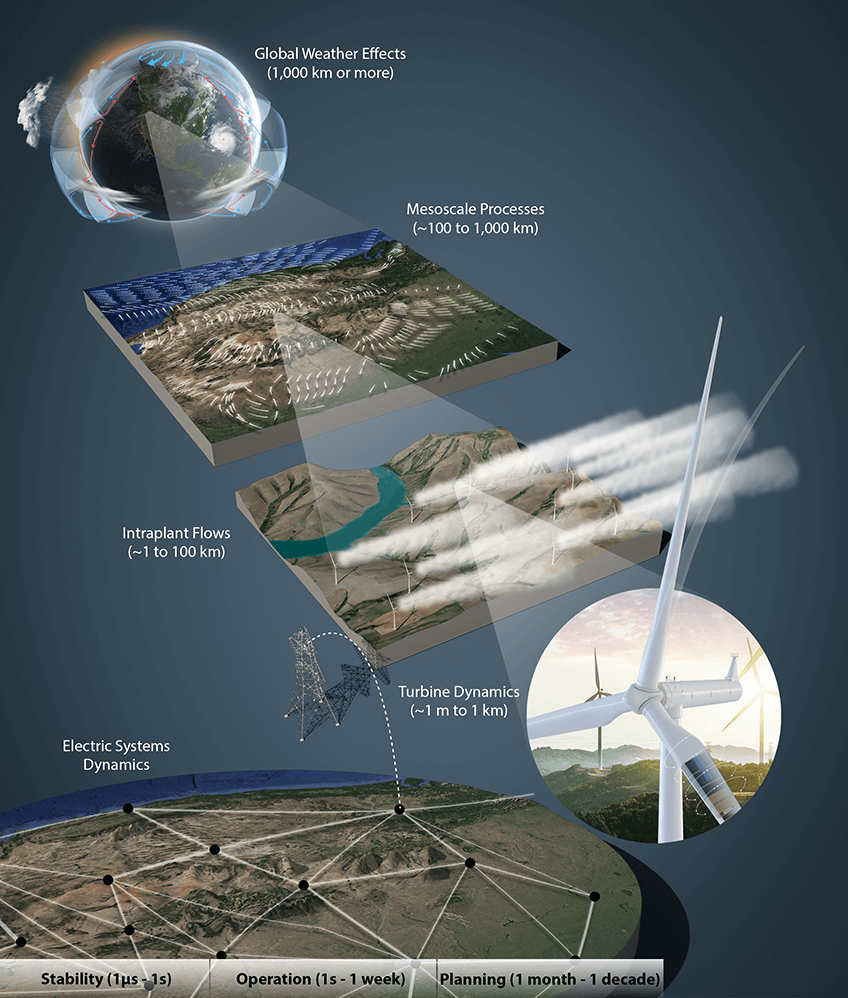News Release: NREL Publishes Science Journal Article Posing Three Challenges to Wind Energy Potential
Wind energy researchers from the U.S. Department of Energy’s National Renewable Energy Laboratory (NREL) are among a team of authors inviting the scientific community to address three challenges that will drive the innovation needed for wind to become one of the world’s primary sources of low-cost electricity generation.
Their call to action appeared in a new journal article published in Science.
“People think that because wind turbines have worked for decades, there’s no room for improvement. And yet, there’s so much more to be done,” said NREL Research Fellow and article co-author Paul Veers. “Wind energy has the potential to be a primary source of low-cost energy for the world, but we won’t get there on a business-as-usual trajectory. We need scientists and researchers worldwide to join us in addressing wind’s research challenges.”

First grand challenge:
Improved understanding of the wind resource and flow in the region of the atmosphere where wind power plants operate
As wind turbines increase in height to capture greater energy resource and wind plants spread over greater distances, we need to understand the dynamics of wind at these elevations and scales. Past use of simplified physical models and basic observational technology has allowed for installation of wind power plants and predictions of performance in a variety of terrain types. But major gaps exist in our knowledge of wind flows in complex terrain or under varying atmospheric stability conditions. The challenge is to model those differing conditions so the wind plant can be optimized, cost-effective, and controllable—and installed in the right location.
Second grand challenge:
Addressing the structural and system dynamics of the largest rotating machines in the world
Wind turbines are now the largest flexible, rotating machines in the world, with blade lengths exceeding 80 meters and towers rising well above 100 meters. To put this in perspective, three of the largest passenger aircrafts—Airbus A380-800s—could fit nose-to-nose within the swept area of one wind turbine rotor. As machines continue getting larger, new materials and manufacturing processes are needed to address the emerging issues of scalability, transportation, and recycling. In addition, the intersection of turbine and atmospheric dynamics raises several important research questions. Many simplifying assumptions on which previous generations of wind turbines were designed no longer apply. The challenge lies not only in understanding the atmosphere, but also in deciphering which factors are critical in both power-generation efficiency and structural safety.
Third grand challenge:
Designing and operating wind power plants to support and foster grid reliability and resiliency
High wind and solar penetrations will drastically change the electricity grids of the future. Wind can provide essential grid services, such as frequency control, ramping, and voltage regulation. Innovative controls could leverage the attributes of wind turbines to optimize plant energy output while supplying these essential services. For instance, using big data techniques on information from sensors distributed on machines around the plant could enhance energy capture, reduce cost, and optimize operations to meet grid requirements. The path to realizing this future will require substantial research at the intersections of atmospheric flow modeling, individual turbine dynamics, and wind plant control with the larger electric system operation.
These wind research grand challenges build on each other. Characterizing the wind power plant operating zone in the atmosphere will be essential to making progress in designing the next generation of even larger low-cost wind turbines. Understanding both dynamic control of the machines and forecasting the nature of the atmospheric inflow will enable the control of the plant needed for grid support.
“Addressing these challenges by taking an interdisciplinary wind energy science and engineering approach will lead to solutions that advance the state of the art in wind plant energy output,” said NREL Associate Lab Director for Mechanical and Thermal Engineering Sciences and article co-author Johney Green. “This approach also provides the integrated solutions necessary for advancing the entire system—from the turbine to the plant to the overall electrical grid—to make us ready for the energy system of the future.”
In addition to Veers, Lantz, Dykes, and Green, “Grand challenges in the science of wind energy” was written by a team of 29 authors from NREL and 19 other organizations. For more information about the international work that formed the basis of NREL’s grand challenges, read the workshop report.
NREL is the U.S. Department of Energy's primary national laboratory for renewable energy and energy efficiency research and development. NREL is operated for the Energy Department by The Alliance for Sustainable Energy, LLC.

